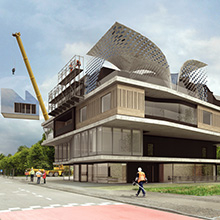Greywater treatment
Greywater treatment: Ensuring stable treatment performance with highly variable inflow
By Angelika Hess
A key challenge for greywater treatment and non-potable reuse on the scale of a building is the inherent high variability of flow and contaminant concentrations. Regardless of these variabilities, safe reuse requires stable effluent water quality at all times. An important goal is to reduce the concentrations of bioavailable organic carbon in order to reach biological stable water to prevent regrowth of pathogens during storage and distribution.
In the Water Hub at NEST we (a team of process engineers and environmental microbiologists) treat the greywater with a membrane bioreactor (MBR) followed by a biological activated carbon (BAC) filter to remove residual organics. This system produces high quality water in terms of physicochemical parameters. However, further disinfection to ensure hygiene is necessary to prevent regrowth of opportunistic pathogens and to remove viruses. The current research is focused on identifying mechanisms to reduce bioavailable organic carbon in the BAC.
We have operated the BAC for more than two years without replacing the activated carbon or backwashing the filter. The main removal mechanism for long-term operation is biological degradation, while sorption can act as a temporary sink during transient periods with elevated influent concentrations. We were able to show that the BAC filter allows for high quality water production in terms of organic carbon as well as suspended bacteria – even with high daily and weekly variabilities of the greywater produced in NEST. With the BAC providing stable effluent due to a combination of biological degradation and temporary sorption, no further buffer tanks and control systems have to be added to the treatment chain.
The focus of my PhD project is on technical and natural science aspects of greywater treatment. But collaboration and discussions within Wings, for example about long-term visions, are very helpful to put my work into a broader perspective. While my project will end next year, different treatment configurations and disinfection options will be tested in the Water Hub to increase the potential for greywater to be reused as a reliable water source.
Key insights
- Even with highly variable greywater in-flow we can produce high quality effluent in terms of physicochemical parameters
- A combination of biological degradation and sorption as a temporary sink provides stable effluent water quality after the BAC

